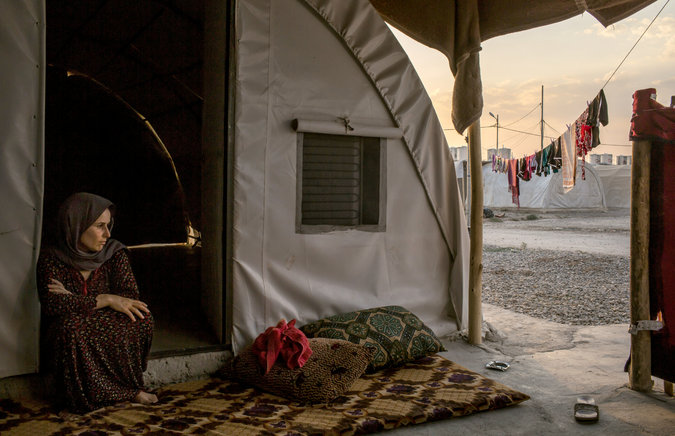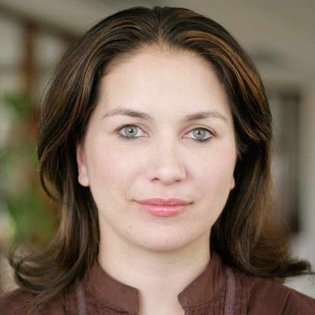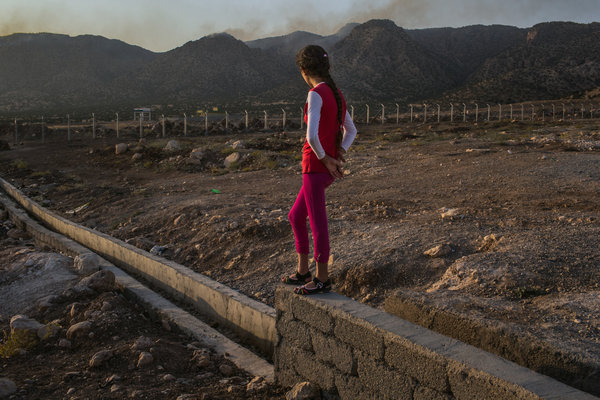Kidnapping and Sex Slavery: Covering Isis’ Religious Justification for Rape
By Erika Allen
Rukmini Callimachi has told the stories of those held as prisoners of the Islamic State before. This week, her front-page article detailed the kidnapping, enslaving and ISIS-sanctioned rape of women and girls from the Yazidi religious minority.
Ms. Callimachi talked to Times Insider about the reporting process that led to devastating first-person accounts from girls as young as 12 who were separated from their families and sold as sex slaves to ISIS fighters. Q: How did you discover this situation of the Islamic State enslaving and raping the Yazidi women and girls? A: Soon after Aug. 3 of last year, when ISIS attacked Sinjar Mountain [in Iraq], we started seeing reports of Yazidi women saying they had been raped. At first, we didn’t know what to make of the reports. They seemed exaggerated, and it seemed hard to believe they had enslaved large numbers of women. Then in October of last year, the turning point for me was when ISIS published a feature article in their flagship magazine, Dabiq, entitled “The Revival of Slavery Before the Hour.” To my horror, they laid out the fact that they had enslaved these women and explained in granular detail the theological justification for taking the Yazidis on the grounds that they are infidels and nonbelievers. They were citing Quranic passages and Islamic scholars who believe the principle that they could be enslaved. That was the minute I became interested in this. I was busy with a lot of other things and couldn't really come until July of this year. That was the beginning of it. Q: How did you get in touch with the women to whom you spoke for the story? A: I got in touch with aid groups that provide psychological services to them or that advocate on their behalf — including Human Rights Watch and Yazda — and I began identifying refugee camps where they live. I then sought out government permission to visit these camps and set out to meet a camp administrator who would put me in touch with a Yazidi elder at the camp who then led me to the women. Q: Tell me about the process of gaining their trust. A: The most important piece of advice that I got was from Matthew Barber at the University of Chicago. He stressed to me the importance of having a Yazidi translator. They are a very small minority — community leaders estimate a population of just 500,000 people. In such a small community, it is hard to find someone who has a good working command of English and is also a Yazidi. I found a translator, and he himself lives in a camp and has relatives who have been abducted, so he is very much perceived as one of them, even though he is male. We took off together, and at every one of these interviews we began by sitting down with the family. The family unit is a very large thing, so we started the interview with about 15 people — parents, grandparents, aunts and uncles sitting around — and then we would explain who we were. I was very clear that I am a journalist, not an aid worker; that I hoped to bring their story to light but am not in a position to help financially, and there is no guarantee that my story will have any direct positive repercussions for them. There had been a lot of complaints following intense media spotlight last year; stories about reporters who came in offering and promising various things. It’s my suspicion it was maybe a problem of translation. But I spoke to one Yazidi woman who said a reporter had approached her and promised her asylum in any European country that she wanted to go to in return for her story. Obviously that is not how a reporter works; I’m guessing that was a problem in translation. But I wanted to be crystal clear about what this interaction would be. That was the first step. After that, I asked the family for permission to be alone with the young woman. And then the interview began. It was the young woman, our translator and me alone in a tent. No interview went for less than an hour. One went for more than three hours. Q: What special considerations do you have to take into account when talking to the victims, particularly those who are still children? A: In the case of the 12-year-old, I interviewed her in the presence of her family. In the other cases, I interviewed them alone. I wanted them to be alone so they wouldn’t be ashamed, especially in front of male relatives. But with the 12-year-old, it felt like that one was on the fence. She is a child. I wanted the family to be present at her side and to essentially vet my questions and make sure I wasn’t asking anything that went too far. In every instance, we asked the women if they wanted to be identified or not. Most said they wanted to be identified by first initial or age. But there were also outliers. There were a couple of women — one older, one younger — who said, very clearly, that they wanted their names used and their faces shown. They said: “We are not ashamed and we are not afraid of them. By hiding in any way, by not identifying ourselves, we would be signaling shame.”
Q: How forthcoming did you find the interview subjects? A: The only interview that was difficult, where I actually stopped the interview, was with a young woman who had been interviewed multiple times by other reporters. I started out explaining to her who I am and letting her know I would be asking her intimate questions that she would be free not to answer if she chose not to. They shouldn’t feel in any way pressured. I interviewed this woman and I could tell there was something off, but she kept on saying, “It’s O.K., it’s O.K., keep going.” But then about 20 minutes in, she basically admitted that the only reason she was talking was that a Yazidi elder had called her in and told her that The New York Times was very important and she really should talk. I stopped and said, you really shouldn’t feel any pressure. I have plenty of other people I am talking to, and if this makes you uncomfortable, I don’t want to be any part of that. So we stopped and basically had a little chitchat about other, unrelated things for another 10 minutes, and then we left. In every other circumstance, I was actively seeking out women who had not spoken to other reporters. Sometimes there is a pile-on effect where someone has spoken to so many people, it dredges up negative emotions and is hard for the person. But in almost every other instance, the women were very forthcoming with me. In one case the interview lasted for more than three hours. At one point, I said to the translator, we have to wrap this up because it’s dark and we have to get back to the hotel. She just wanted to keep talking. Q: Were there any outliers in the stories that you heard? A: The template of their experience was unbelievable cruelty. But there were a couple of instances of people within the Islamic State who showed kindness or who helped these women escape or put together some of the key logistics needed for escape. One woman told me about how she was sent to a shop to buy provisions for the house because she was also used as a sort of domestic slave, and a shopkeeper was willing to let her use his phone and call her family. From that, her family was able to identify where she was and send a smuggler to get her out. But you know, that was by far the exception. Q: How you are able to deal with these situations, to listen to stories like these coming from young kids who have experienced brutality? A: I don’t think there is anything wrong with, when you hear something horrifying of deep personal suffering, nothing wrong in showing emotion. There was one interview with a 15-year-old girl who explained how she had tried to commit suicide. She explained how angry she was for not having been able to kill herself because the failure to commit suicide meant she had to keep on being raped, and she buckled over in the middle of the interview and started to cry. My translator and I looked at each other, and our eyes were welling up with tears. It is awful to see someone in that kind of suffering. It is so awful. She is so innocent. She is 15, and was 14 when this was happening. I don’t think that showing that emotion taints the writing. What happened to her is an unadulterated horror. And that is what I tried to report. Q: Did you work with Mauricio Lima at all as he photographed the young women? How did you all think of how to hide their identities in photos? A: We worked separately. I had already finished my reporting when Mauricio arrived. In general it is harder to get a portrait of someone in which they can’t be recognized than it is to protect an identity in an interview. Mauricio’s job was harder than mine on this particular assignment. Q: How does this story fit in among the other recent kidnappings and mass rapes that have happened recently? With the Yazidi issue there was a burst of reporting last August, when people were fleeing the mountain: the dramatic images of helicopters landing and people trying to scramble on board. Then it quickly died down. I compare it to the coverage of the Chibok girls in Nigeria — 300 girls kidnapped by Boko Haram, a group that is now part of ISIS. There was constant front-page coverage of those girls; there was a hashtag, “Free the Chibok Girls,” “Bring Back Our Girls,” and just a constant drumbeat of coverage. By contrast, the Yazidi numbers are 10 times that of the Chibok. There are still roughly 3,200 Yazidi, mostly women and girls, who are still enslaved. We know their names, their hometowns, ages, in many cases we know where they are being held. Certainly the coverage has not been 10 times that of the Chibok girls. I don’t know why that disparity is there. Perhaps we have become inured to ISIS atrocities, and this is another chapter of that. I think it’s important to keep a spotlight on this. Girls are being smuggled out on the order of one or two a week; families are struggling to raise money to get them out. We need to continue to hold up the light of truth. Q: Do you ever feel threatened or endangered when you report on ISIS? A: There has been an occasional threat against me by Islamic State fighters, just as there are against any reporter who covers the subject. I don’t believe any are serious and they do not affect the way I do my reporting.
|
.
Any original material on these pages is copyright © BishopAccountability.org 2004. Reproduce freely with attribution.


